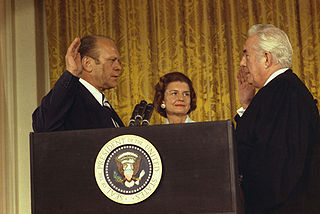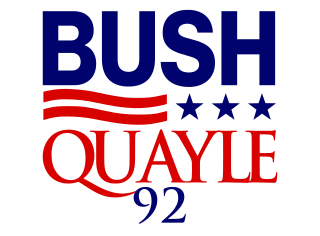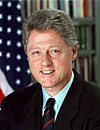
William Jefferson Clinton is an American politician who served as the 42nd president of the United States from 1993 to 2001. A member of the Democratic Party, he previously served as Governor of Arkansas from 1979 to 1981 and again from 1983 to 1992. Clinton, whose policies reflected a centrist "Third Way" political philosophy, became known as a New Democrat.

George Herbert Walker Bush was an American politician, diplomat, and businessman who served as the 41st president of the United States from 1989 to 1993. A member of the Republican Party, he also served as the 43rd vice president from 1981 to 1989 under Ronald Reagan, and in various other federal positions prior to that.

Bill Clinton's tenure as the 42nd president of the United States began with his first inauguration on January 20, 1993, and ended on January 20, 2001. Clinton, a Democrat from Arkansas, took office following his victory over Republican incumbent president George H. W. Bush and independent businessman Ross Perot in the 1992 presidential election. Four years later, in the 1996 presidential election, he defeated Republican nominee Bob Dole and Perot again, to win re-election. Clinton was limited to two terms and was succeeded by Republican George W. Bush, who won the 2000 presidential election.
This section of the timeline of United States history includes major events from 1990 to 2009.

The weekly address of the president of the United States is the weekly speech by the president of the United States to the nation. Franklin D. Roosevelt was the first U.S. president to deliver such radio addresses. Ronald Reagan revived the practice of delivering a weekly Saturday radio broadcast in 1982, and his successors all continued the practice until Donald Trump ceased doing so seventeen months into his term.

The inauguration of Gerald Ford as the 38th president of the United States was held on Friday, August 9, 1974, in the East Room of the White House in Washington, D.C., after President Richard Nixon resigned due to the Watergate scandal. The inauguration – the last non-scheduled, extraordinary inauguration to take place in the 20th century – marked the commencement of Gerald Ford's only term as president. Chief Justice Warren E. Burger administered the oath of office. The Bible upon which Ford recited the oath was held by his wife, Betty Ford, open to Proverbs 3:5–6. Ford was the ninth vice president to succeed to the presidency intra-term, and he remains the most recent to do so, as of 2024.

The first inauguration of Bill Clinton as the 42nd president of the United States was held on Wednesday, January 20, 1993, at the West Front of the United States Capitol in Washington, D.C. This was the 52nd inauguration and marked the commencement of the first term of Bill Clinton as president and Al Gore as vice president. At 46 years, 154 days of age at the time of his first inauguration, Clinton was the third-youngest person to become president, and the first from the Baby Boomer generation.

The first inauguration of George W. Bush as the 43rd president of the United States took place on Saturday, January 20, 2001, at the West Front of the United States Capitol in Washington, D.C. This was the 54th inauguration and marked the commencement of the first term of George W. Bush as president and Dick Cheney as vice president. Chief Justice William Rehnquist administered the presidential oath of office at 12:01 p.m., after he administered the vice presidential oath of office as well. An estimated 300,000 people attended the swearing-in ceremony. This was the first presidential inauguration to take place in the 21st century, and the first in the 3rd millennium.

The second inauguration of Bill Clinton as the 42nd president of the United States was held on Monday, January 20, 1997, at the West Front of the United States Capitol Building in Washington, D.C. This was the 53rd inauguration and marked the commencement of the second and final term of Bill Clinton as president and Al Gore as vice president. This was the last presidential inauguration to take place in the 20th century, the last in the 2nd millennium, and the first to be streamed live on the internet.
The post-presidency of Bill Clinton began on January 20, 2001 following the end of Bill Clinton's second term as president. Clinton was the 42nd president of the United States, serving from 1993 to 2001. After he left office, he continued to be active in the public sphere, touring the world, writing books, and campaigning for Democrats, including his wife, Hillary Clinton, who served as the junior U.S. senator from New York between 2001 and 2009 and the 67th United States Secretary of State between 2009 and 2013, on her presidential campaigns in 2008, in which she was runner-up for the Democratic nomination, and in 2016, when she lost the election to Donald Trump. After Clinton left office, he ended up forming a close friendship with George H. W. Bush and later, with George W. Bush.
Barack Obama, a Democrat from Illinois, was elected President of the United States on November 4, 2008 and was inaugurated as the nation's 44th president on January 20, 2009. Re-elected on November 6, 2012, his second inauguration was on January 20, 2013, and his presidency ended on January 20, 2017, with the inauguration of Donald Trump. The following articles cover the timeline of Obama's presidency, and the time leading up to it:

The 1996 United States presidential election in New Hampshire took place on November 5, 1996, as part of the 1996 United States presidential election. Voters chose four representatives, or electors to the Electoral College, who voted for president and vice president.

The presidential transition of George W. Bush took place following the 2000 United States presidential election. It started after Bush was declared the victor of the election on December 12, 2000, when the Bush v. Gore decision by the Supreme Court halted the election recount in Florida, making Bush the victor in that state. The decision delivered him the state's 25 electoral votes, thus giving him a total of 271 electoral votes. This was one more vote than the 270 needed to win the presidency outright, making him president-elect.
George W. Bush, a Republican from Texas, was elected President of the United States on December 12, 2000 and was inaugurated as the nation's 43rd president on January 20, 2001. Re-elected on November 2, 2004, his second inauguration was on January 20, 2005, and his presidency ended on January 20, 2009, with the inauguration of Barack Obama. The following articles cover the timeline of Bush's presidency, and the time leading up to it:
George H. W. Bush, a Republican from Texas, was elected President of the United States on November 8, 1988 and was inaugurated as the nation's 41st president on January 20, 1989, and his presidency ended on January 20, 1993, with the inauguration of Bill Clinton. The following articles cover the timeline of Bush's presidency, and the time leading up to it:
This bibliography of Bill Clinton is a selected list of generally available published works about Bill Clinton, the 42nd president of the United States. Further reading is available on Bill Clinton, his presidency and his foreign policy, as well as in the footnotes in those articles.
The following is a timeline of the presidency of Bill Clinton, from January 1, 2000 to January 20, 2001.
On January 20, 1993, following the first inauguration of his successor Bill Clinton, George H. W. Bush and his wife Barbara Bush built a retirement house in the community of West Oaks, Houston. He established a presidential office within the Park Laureate Building on Memorial Drive in Houston. He also frequently spent time at his vacation home in Kennebunkport, took annual cruises in Greece, went on fishing trips in Florida, and visited the Bohemian Club in Northern California. He declined to serve on corporate boards, but delivered numerous paid speeches and served as an adviser to The Carlyle Group, a private equity firm. He never published his memoirs, but he and Brent Scowcroft co-wrote A World Transformed, a 1998 work on foreign policy. Portions of his letters and his diary were later published as The China Diary of George H. W. Bush and All the Best, George Bush.

The presidential transition of Bill Clinton began when he won the United States presidential election on November 3, 1992, and became the president-elect. Clinton was formally elected by the Electoral College on December 14, 1992. The results were certified by a joint session of Congress on January 8, 1993, and the transition ended when Clinton was inaugurated at noon EST on January 20, 1993.

The 1992 presidential campaign of George H. W. Bush was an unsuccessful re-election campaign for 1992 United States presidential election by incumbent president George H. W. Bush, who had taken office on January 20, 1989. Bush and incumbent vice president Dan Quayle were defeated by Democratic presidential nominee Bill Clinton and vice presidential nominee Al Gore. Bush, a Republican president and former vice president under Ronald Reagan, launched his presidential bid on October 11, 1991 and secured nomination for his re-election on August 20, 1992. He was challenged in the Republican primaries by former White House Communications Director Pat Buchanan, who received less than one percent of the delegates in the Republican National Convention.














